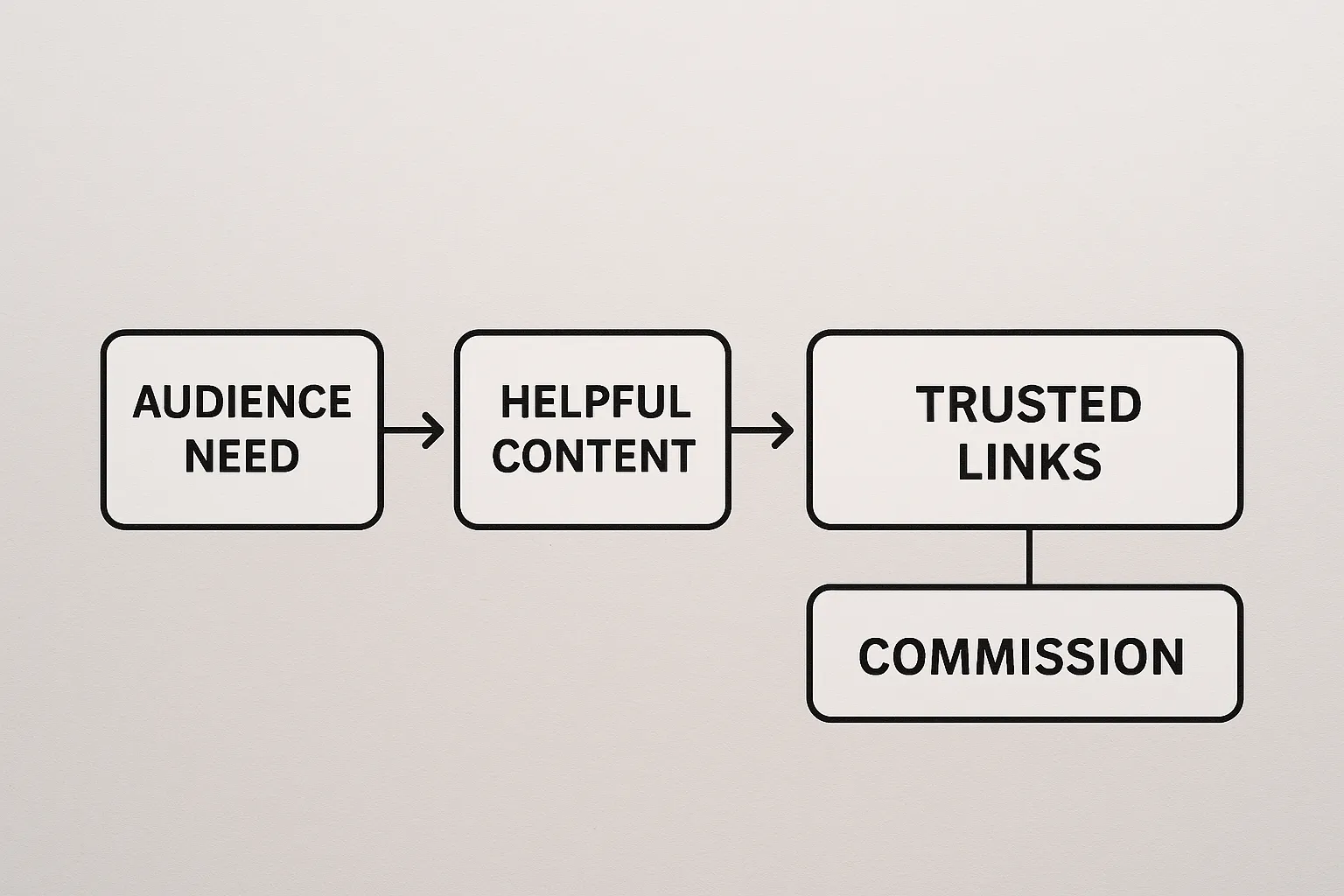
Affiliate marketing remains one of the lowest-barrier, highest-leverage ways to build an online income stream. The channel is projected to reach $17 billion in global spend by 2027 (Statista, 2024) as brands keep shifting budgets toward performance-based partnerships. If you have wifi, curiosity, and the willingness to publish helpful content, you can claim a slice of that pie. This starter playbook walks you through exactly what to do in your first 30 days so you can move from “I should try affiliate marketing” to earning your first commissions.

1. Affiliate Marketing in One Minute
- You recommend a product or service you do not own.
- A unique tracking link records clicks and sales.
- The merchant handles fulfilment and support.
- You receive a pre-agreed commission once a sale is verified.
That’s it. Your only job is to match the right audience with the right offer through helpful content or strategic promotion.
2. The Non-Negotiable Foundation Checklist
Before you sprint into link-posting mode, lock down these essentials:
| Asset | Why It Matters | Fast Action |
|---|---|---|
| Defined niche | Focus builds topical authority and better SEO signals | List ten problems you can genuinely help solve and pick one cluster |
| Owned platform | You control your traffic and can add conversion elements | Register a domain and set up WordPress hosting. See our comparison of the [best 10 web hosts](https://jyab.blog/best-10-web-hosting-companies-in-the-world-paid-free/) |
| Audience insight | Knowing pains and language increases conversion | Hang out in subreddit threads, Quora, Amazon reviews, or Facebook groups |
| Value engine | Content, email, or tools that answer questions | Draft a 1-page outline for a lead magnet or cornerstone guide |
| Compliance mindset | Required by law and builds trust | Add a footer disclosure: “As an Amazon Associate … ” |
Get these five boxes ticked and you’re ahead of most beginners who chase commissions before credibility.
3. The 30-Day Starter Playbook
Use this timeline as a structured sprint. Adjust pace as needed but keep the order—each block builds on the last.
Days 1-3: Niche Validation
- List three micro-niches where you have experience or genuine interest (e.g., gluten-free meal kits, budget travel hacking, indie game dev tools).
- Run quick keyword checks with free tools such as Google Trends and Answer the Public. Look for search terms with 500-5 000 monthly volume and low competition.
- Audit affiliate program availability. A niche with no commissionable products is a dead end.
Days 4-7: Platform Setup
- Register a memorable .com or .blog domain.
- Install WordPress; apply a lightweight SEO-friendly theme (Astra, Kadence, GeneratePress).
- Create core pages: About, Contact, Privacy Policy, Affiliate Disclosure.
- Connect Google Search Console and Google Analytics 4.
Days 8-14: Content Foundation
- Publish two pillar articles (1 500+ words each) targeting buyer-intent keywords. For example, “Best Air Purifiers for 1-Bedroom Apartments (2025 Review)”.
- Add internal links between the pillars and future supporting posts to create a topic cluster.
- Create a simple lead magnet (checklist, template, or mini eBook) and connect a basic email service such as ConvertKit.
Days 15-21: Traffic Launch
- Perform on-page SEO: descriptive slug, H1 with primary keyword, H2 clusters, alt text.
- Share posts in niche communities where self-promo is allowed. Always lead with value, not links.
- Set up Pinterest or LinkedIn (depending on audience) and schedule five pins/posts using free plans on Buffer.
Days 22-26: Conversion Layer
- Join at least three affiliate programs: a network (Impact, CJ), a marketplace (Amazon Associates), and a high-ticket SaaS offer.
- Insert contextual links: name of product + benefit + hyperlink. Avoid banners that look like ads.
- Add comparison tables or call-out boxes summarising key features—these increase click-through up to 34 percent (Awin Report, 2023).
Days 27-30: Analytics and Optimisation
- In GA4 set up Events for outbound link clicks so you can measure where revenue originates.
- Use Pretty Links or ThirstyAffiliates to cloak and manage URLs.
- Each evening, record pageviews, clicks, and EPC (earnings per click) in a spreadsheet. Early data is tiny but trends matter.
Finish the sprint by writing a “Month 1 Recap” post. Transparency builds audience loyalty and attracts backlinks from case-study curators.
4. How to Pick Affiliate Programs That Actually Pay
| Program Type | Typical Commission | Cookie Window | Best For |
|---|---|---|---|
| High-ticket SaaS (e.g., web hosting, funnel builders) | 20–70 USD per sale | 30–90 days | Bloggers comfortable with in-depth reviews |
| Evergreen marketplaces (Amazon, ClickBank) | 1–10 percent | 24 hours – 60 days | Beginners needing breadth of products |
| Physical subscription boxes | 5–15 percent recurring | 30 days | Lifestyle niches (pets, wellness) |
| Digital templates or courses | 30–50 percent | 60–365 days | Education or B2B creators |
Scan each prospective partner for:
- Clear reporting dashboard
- Transparent payout thresholds and methods
- Active support or affiliate manager
- Solid reputation (quick Reddit search for “program + scam” can save headaches)
5. Stay Legal and Build Trust From Day One
The US FTC requires “clear and conspicuous” disclosure of affiliate relationships. Put a short statement above the fold in every post with links and add a page-footer disclosure. Outside the US, similar laws exist, and many networks will kick you out for non-compliance.
Honesty also converts. A 2024 Edelman Trust Barometer survey found that 71 percent of consumers make purchasing decisions based on whether they trust the source. Admitting drawbacks and linking to third-party reviews increases believability.
6. Growth Levers After Your First Commissions
- Repurpose a high-performing post into a YouTube script or podcast episode to capture new channels.
- Automate research and drafting with writing assistants—see our roundup of the best AI tools for online success.
- Build topical clusters around adjacent sub-niches to increase topical authority and organic traffic.
- Re-invest a portion of earnings into paid traffic experiments (Pinterest ads, Google Performance Max) and track ROI meticulously.
7. Classic Pitfalls and How to Dodge Them
- Shiny-object syndrome: hopping niches every month resets your SEO clock. Commit to at least six months.
- Blind link dumping: promote only products you have tested or deeply researched. Refunds can claw back your commissions.
- Ignoring list building: algorithms change; an email list is insurance.
- Analysis paralysis: you do not need the perfect theme, plugin stack, or logo to start. Publish and improve later.

8. The Next Step Is Action
Reading playbooks will not generate commission notifications. Pick a niche tonight, secure a domain, and publish your first 700-word post before the weekend. Then follow the 30-day timeline above. For additional inspiration, revisit our beginner’s guide on how to make money online using AI and our deep dive into affiliate marketing fundamentals.
Affiliate marketing rewards creators who move quickly, iterate, and serve audiences honestly. Start now, and let your future self thank you for planting an income seed that can compound for years.
Leave a Reply